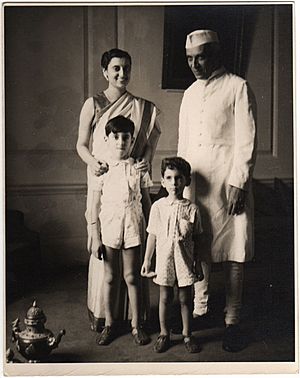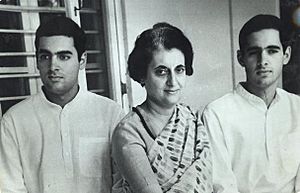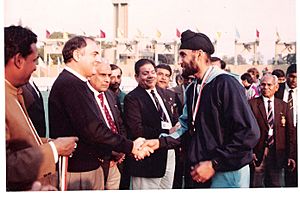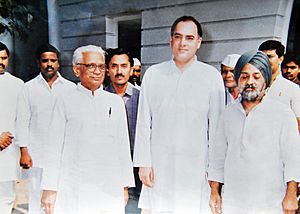Rajiv Gandhi facts for kids
Quick facts for kids
Rajiv Gandhi
|
|
|---|---|
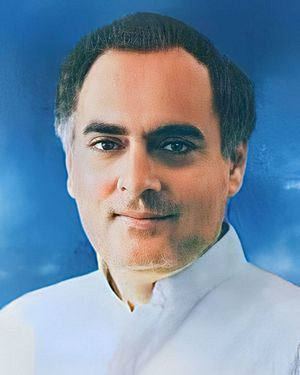 |
|
| 6th Prime Minister of India | |
| In office 31 October 1984 – 2 December 1989 |
|
| President | Zail Singh R. Venkataraman |
| Vice President | R. Venkataraman Shankar Dayal Sharma |
| Preceded by | Indira Gandhi |
| Succeeded by | V. P. Singh |
| Leader of the Opposition, Lok Sabha | |
| In office 18 December 1989 – 23 December 1990 |
|
| Prime Minister | V. P. Singh |
| Preceded by | Jagjivan Ram |
| Succeeded by | L. K. Advani |
| President of the Indian National Congress | |
| In office 28 December 1985 – 21 May 1991 |
|
| Preceded by | Indira Gandhi |
| Succeeded by | P. V. Narasimha Rao |
| Member of Parliament, Lok Sabha | |
| In office 17 August 1981 – 21 May 1991 |
|
| Preceded by | Sanjay Gandhi |
| Succeeded by | Satish Sharma |
| Constituency | Amethi |
| Personal details | |
| Born |
Rajiv Ratna Gandhi
20 August 1944 Bombay, Bombay Presidency, British India (present-day Mumbai, Maharashtra, India) |
| Died | 21 May 1991 (aged 46) Sriperumbudur, Tamil Nadu, India |
| Cause of death | Assassination |
|
Monuments
|
Veer Bhumi
|
| Political party | Indian National Congress |
| Spouse | |
| Relations | See Nehru–Gandhi family |
| Children | |
| Parents |
|
| Alma mater | Trinity College, Cambridge (dropped out) Imperial College London (dropped out) |
| Awards | Bharat Ratna (1991) |
| Signature |  |
Rajiv Gandhi (![]() i/ˈrɑːdʒiːv ˈɡɑːndiː/; 20 August 1944 – 21 May 1991) was an Indian politician. He served as the sixth prime minister of India from 1984 to 1989. He became prime minister after his mother, Indira Gandhi, was assassinated. At 40 years old, he was the youngest Indian Prime Minister ever.
i/ˈrɑːdʒiːv ˈɡɑːndiː/; 20 August 1944 – 21 May 1991) was an Indian politician. He served as the sixth prime minister of India from 1984 to 1989. He became prime minister after his mother, Indira Gandhi, was assassinated. At 40 years old, he was the youngest Indian Prime Minister ever.
Gandhi came from the powerful Nehru–Gandhi family, which was closely linked to the Indian National Congress party. His grandfather, Jawaharlal Nehru, was prime minister for much of Rajiv's childhood. Rajiv studied at the University of Cambridge in the United Kingdom. In 1966, he returned to India and became a pilot for Indian Airlines. In 1968, he married Sonia Gandhi. They lived in Delhi with their children, Rahul Gandhi and Priyanka Gandhi Vadra.
Even though his mother was prime minister and his brother was an MP, Rajiv Gandhi stayed out of politics for many years. After his brother Sanjay died in a plane crash in 1980, Indira asked Rajiv to enter politics. He agreed, though he was hesitant at first. The next year, he won his brother's seat in Parliament for Amethi. He became a member of the Lok Sabha, which is the lower house of India's Parliament. Rajiv was made a general secretary of the Congress party. He also played a big part in organizing the 1982 Asian Games.
On 31 October 1984, his mother, Prime Minister Indira Gandhi, was assassinated. She was killed by her two Sikh bodyguards. This happened after Operation Blue Star, a military action at the Golden Temple. Later that day, Gandhi became prime minister. His leadership was tested by riots against the Sikh community in Delhi. In December that year, the Congress party won a huge victory in the election. They won 411 out of 542 seats.
Rajiv Gandhi's time as prime minister had some challenges. These included the Bhopal disaster and the Bofors scandal. In 1988, he helped stop a coup in Maldives. He also sent peacekeeping troops to Sri Lanka in 1987. This led to conflict with the Liberation Tigers of Tamil Eelam (LTTE). The Bofors scandal hurt his image and led to his party's defeat in the 1989 election.
Gandhi remained the Congress President until the elections in 1991. He was assassinated while campaigning for these elections. In 1991, the Indian government gave Gandhi the Bharat Ratna. This is the country's highest award for civilians.
Contents
Early Life and Education
Rajiv Gandhi was born in Bombay on 20 August 1944. His parents were Indira and Feroze Gandhi. In 1951, Rajiv and his younger brother Sanjay went to Shiv Niketan school. Teachers said Rajiv was shy and quiet. He really enjoyed painting and drawing.
He later attended Welham Boys' School and Doon School in Dehradun. Sanjay joined him at Doon School two years later. Rajiv also studied at the Ecole d'Humanité, an international boarding school in Switzerland. He left Doon School in 1961.
After Doon, Gandhi applied to Cambridge University. He was accepted into Trinity College in October 1962. While at Trinity, he joined the Cambridge University Boat Club. Gandhi left Trinity in 1965 without a degree. He then started a mechanical engineering course at Imperial College London in 1966. However, he did not finish that course either. Gandhi later admitted he was not very studious.
In 1966, Gandhi returned to India. His mother had just become prime minister. He joined the Flying Club in Delhi and trained as a pilot. In 1970, he started working as a pilot for Indian Airlines. Unlike his brother Sanjay, Rajiv was not interested in politics at this time.
In 1968, he married Edvige Antonia Albina Màino. She changed her name to Sonia Gandhi and made India her home. Their son, Rahul Gandhi, was born in 1970. In 1972, they had a daughter, Priyanka Gandhi. Rajiv was also a friend of actor Amitabh Bachchan.
Entering Politics
On 23 June 1980, Rajiv's younger brother, Sanjay Gandhi, died in a plane crash. Rajiv was in London at the time. He quickly returned to Delhi for Sanjay's funeral.
After Sanjay's death, many members of the Congress party asked Indira for Rajiv to enter politics. Indira said it was Rajiv's choice. He replied, "If my mother gets help from it, then I will enter politics." Rajiv officially entered politics on 16 February 1981. He spoke at a large farmers' rally in Delhi. At this time, he was still working for Air India.
First Steps in Politics
On 4 May 1981, the All India Congress Committee met. They suggested Rajiv as a candidate for the Amethi constituency. All members agreed. A week later, the party announced his candidacy. He won the seat, beating Lok Dal candidate Sharad Yadav by a large number of votes. He became a Member of Parliament on 17 August.
Rajiv Gandhi's first political trip was to England. He attended the wedding of Prince Charles and Lady Diana Spencer in July 1981. In December that year, he was put in charge of the Indian Youth Congress. He showed his organizing skills by working very hard on the 1982 Asian Games. He was part of the Games' organizing committee. His "drive, zeal and initiative" helped make the games a big success.
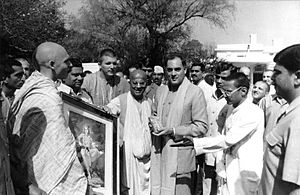
Prime Minister of India
Rajiv Gandhi was in West Bengal on 31 October 1984. That day, his mother, Prime Minister Indira Gandhi, was assassinated. She was killed by her Sikh bodyguards, Satwant Singh and Beant Singh. They wanted revenge for the military attack on the Golden Temple.
Within hours of her death, Sardar Buta Singh and President Zail Singh urged Rajiv to become prime minister. Rajiv Gandhi said, "When a giant tree falls, the earth below shakes." This statement was criticized by many. Some Congress politicians were accused of planning the violence.
Soon after becoming prime minister, Gandhi asked President Singh to hold new elections. The Lok Sabha had finished its five-year term. Gandhi officially became the president of the Congress party. The party won a huge victory in the election. They got the largest majority in the history of the Indian Parliament. This gave Gandhi full control of the government. People saw him as young and free from corruption. Gandhi took his oath on 31 December 1984. At 40, he was India's youngest prime minister.
Cabinet Ministers
After becoming prime minister, Gandhi chose his fourteen-member cabinet. He said he would watch their work closely. He would "fire ministers who do not come to the mark." He removed two powerful figures from the previous government: Finance Minister Pranab Mukherjee and Railway Minister A. B. A. Ghani Khan Choudhury. Mohsina Kidwai became the Minister of Railways. She was the only woman in the cabinet. V. P. Singh, who was first the Finance Minister, later became the Defence Minister in 1987. Gandhi often changed his cabinet ministers. This led to some criticism.
Anti-Defection Law
Gandhi's first action as prime minister was passing the anti-defection law in January 1985. This law meant that an elected Member of Parliament or state assembly could not join an opposition party until the next election. This law aimed to stop corruption. It prevented ministers from switching parties just to gain power or money. Many such defections had happened in the 1980s.
Shah Bano Case
In 1985, the Supreme Court of India ruled in favor of Shah Bano, a Muslim woman who had divorced. The court said her husband should pay her alimony. Some Indian Muslims felt this went against Muslim Personal Law. They protested against the ruling. Gandhi agreed to their demands. In 1986, the Parliament of India passed a law that changed the Supreme Court's judgment. This new law allowed divorced Muslim women to receive maintenance payments only for a short period after divorce.
Economic Policy
In his election promises for 1984, Gandhi did not mention economic reforms. But after becoming prime minister, he tried to make India's economy more open. He wanted to make private businesses more profitable. He gave support to companies to increase industrial production. This was especially true for things like household goods. It was hoped this would help the economy grow.
Gandhi increased government support for science, technology, and related industries. He also lowered taxes on technology-based industries. These included computers, airlines, defense, and telecommunications. In 1986, he announced a National Policy on Education. This plan aimed to improve and expand higher education across India. In 1986, he also started the Jawahar Navodaya Vidyalaya System. These are government schools that offer free education to rural children from grades six to twelve.
His efforts led to the creation of MTNL in 1986. His public call offices (PCOs) helped develop telephone networks in rural areas. He also took steps to reduce the Licence Raj after 1990. This made it easier for businesses and people to buy and import goods without too many government rules.
Foreign Policy
Rajiv Gandhi wanted India to be a strong and independent nation. His foreign policy aimed to make India a leader among world nations. His diplomacy was flexible. He was willing to cooperate when needed and be firm when necessary.
In 1986, the president of Seychelles asked for help. Gandhi sent India's navy to Seychelles to stop a coup attempt. This mission was called Operation Flowers are Blooming. In 1987, India took back the Quaid Post in the disputed Siachen region. This was called Operation Rajiv. In the 1988 Maldives coup d'état, the Maldives president asked Gandhi for help. Gandhi sent 1500 soldiers, and the coup was stopped.
On 9 June 1988, Gandhi spoke at the United Nations General Assembly. He shared his ideas for a world free of nuclear weapons. He proposed an "Action Plan for Ushering in a Nuclear-Weapon Free and Non-Violent World Order."
Relations with Pakistan
In February 1987, Pakistan's president visited Delhi. He met Gandhi to talk about military exercises near the borders. In December 1988, Gandhi visited Islamabad. He met the new prime minister of Pakistan, Benazir Bhutto. They confirmed the 1972 Shimla agreement.
Relations with Sri Lanka
The Sri Lankan Civil War began with the Liberation Tigers of Tamil Eelam (LTTE). This group wanted an independent Tamil state in Sri Lanka. Gandhi discussed this with the Sri Lankan Prime Minister in 1986. That year, the Sri Lankan army blocked the Tamil area of Jaffna. Gandhi ordered relief supplies to be dropped by parachute. This was because the Sri Lankan navy did not allow the Indian Navy to enter.
Gandhi signed the Indo-Sri Lanka Accord in July 1987. This agreement aimed to give more power to Tamil areas. It also aimed to disarm the LTTE. Tamil was made an official language of Sri Lanka.
Assault by Sri Lankan Guard
On 30 July 1987, a day after signing the accord, Gandhi was in Sri Lanka. An honor guard named Vijitha Rohana hit him on the shoulder with his rifle. Gandhi quickly reacted, avoiding serious injury. The guard was then taken away by security. The guard said he wanted to kill Gandhi because of the "damage he had caused" to Sri Lanka.
Regional Issues
Punjab
Soon after becoming prime minister, Gandhi released leaders of the Akali Dal. They had been in prison since 1984. He also lifted the ban on the All India Sikh Students Federation. He started an investigation into the 1984 Anti-Sikh Riots. He met with Akali Dal leaders to find a solution for the Punjab problem.
In January 1985, Gandhi signed the Rajiv-Longowal Accord with Akali leader HS Longowal. In May 1988, Gandhi started Operation Black Thunder. This operation aimed to clear the Golden Temple in Amritsar of weapons and gunmen. Special groups surrounded the temple for 10 days. The extremists' weapons were taken away.
Northeast India
During Gandhi's time as prime minister, there was an increase in unrest in northeast India. The Mizo National Front wanted independence for Mizoram. In 1987, Gandhi addressed this problem. Mizoram and Arunachal Pradesh became states. They were previously union territories.
Gandhi also ended the Assam Movement. This movement was started by Assamese people. They protested against the illegal migration of Bangladeshi Muslims and other Bengalis to their state. Gandhi signed the Assam Accord on 15 August 1985. This agreement gave full citizenship to foreigners who came between 1951 and 1961. Those who arrived between 1961 and 1971 could not vote for ten years.
Technology Advancements
Gandhi hired Sam Pitroda as his advisor on public information and technology. During Gandhi's time, public telecom companies like MTNL and VSNL were developed. According to Pitroda, Gandhi helped spread telephone services across India. This was important for India's development. News website Oneindia said, "About 20 years ago telephones were considered to be a thing for the use of the rich, but credit goes to Rajiv Gandhi for taking them to the rural masses."
Gandhi's government also allowed the import of computer parts. This helped lower the price of computers. Many people believe that the start of India's information technology (IT) revolution happened during Rajiv Gandhi's time.
Later Years and Assassination
Bharat Yatra Programs
In 1990, Rajiv Gandhi traveled across India in different ways. He walked and rode in a second-class train carriage. He started his 'Bharat Yatra' from Champaran. Rajiv Gandhi also began the Sadbhavna Yatra from Charminar in Hyderabad on 19 October 1990.
Assassination
Rajiv Gandhi's last public meeting was on 21 May 1991. It was in Sriperumbudur, a village near Madras (now Chennai). He was campaigning for a Congress candidate when he was assassinated.
A state funeral was held for Gandhi on 24 May 1991. It was shown live on TV. Dignitaries from over 60 countries attended. He was cremated at Veer Bhumi. This is near the memorials of his mother Indira Gandhi, brother Sanjay Gandhi, and grandfather Jawaharlal Nehru.
Since his death, 21 May has been named Anti-Terrorism Day in India.
Institutions Named After Gandhi
Many government projects and schemes are named after the Nehru–Gandhi family. In May 2012, Zee News reported that 16 government schemes were named after Gandhi. These included Rajiv Awas Yojana. In March 2015, a minister said there were 232 rural stadiums in India. 226 of them were named after Rajiv Gandhi.
Images for kids
See also
 In Spanish: Rajiv Gandhi para niños
In Spanish: Rajiv Gandhi para niños


